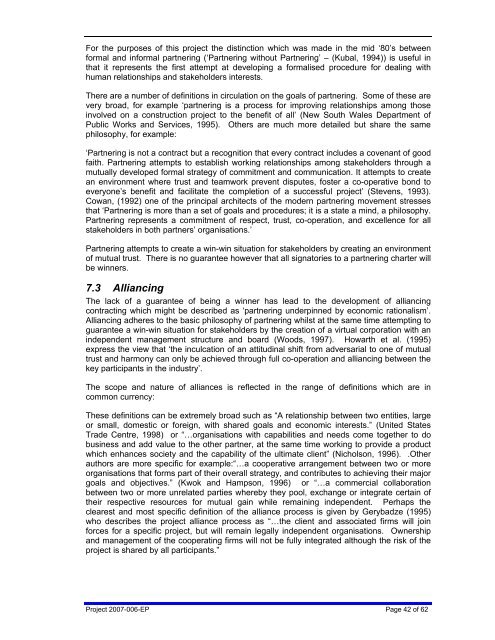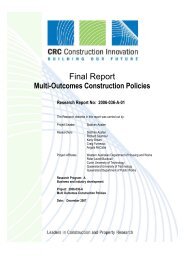By way of explanation of the above Figure McGeorge <strong>and</strong> Palmer (2002) make the statementthat:‘The probability is that the relatively slow <strong>and</strong> patchy uptake of modern constructionmanagement concepts is due not so much to the lack of diligence or a reluctance on the partof construction industry practitioners to adopt new ideas, but to the fact that these conceptsneed firstly to be understood <strong>and</strong> studied in total. Secondly, although government agenciesare encouraging <strong>and</strong>, in some cases attempting to enforce the adoption of the concepts, noadvice is being given on how these concepts can be applied concurrently <strong>and</strong> incombination. What is need is a weltanschauung or ‘world view’ based on a solid knowledgeof the individual concepts.’7.1 BackgroundThe management concepts in Figure 2 are illustrative of a range of concepts which mayproduce a non-adversarial culture <strong>and</strong> hence avoid disputation. Although there is aninherent risk in attempting to link the concepts through a single theme there is obviousevidence of systems thinking in a number, if not all, of the concepts, with emphasis beingplaced on a holistic approach (Checkl<strong>and</strong> & Scholes, 1999) Systems thinking carries with itan undercurrent of stakeholder involvement which is clearly evident in concepts such asalliancing, <strong>and</strong> partnering. Recent approaches to improving both inter <strong>and</strong> intraorganisational relationships would seem to be very much focused on stakeholderinvolvement as demonstrated in publications such as ‘The stakeholder theory of thecorporation: concepts, evidence, <strong>and</strong> implications' (Donaldson & Preston, 1995), ‘ValueAlignment for Project Delivery’ (Sidwell, 2001) <strong>and</strong> ‘Stakeholder impact analysis inconstruction project management’ (Ol<strong>and</strong>er, 2006). The underlying premise being that themore engagement that stakeholders have in the construction process, then more harmoniouswill be working relationships <strong>and</strong> hence the levels of disputation will be reduced. As anexample of the counterpoint to pro-active engagement Sidwell cites Eggleton (2001) inillustrating adversarial relationships in the construction industry. Eggleton describes aconventional situation with the client being intent on obtaining the maximum amount of scopefor the cheapest possible cost, within the time frame. The contractor’s attitude being theconverse to that of the client. Ol<strong>and</strong>er cites Bourne <strong>and</strong> Walker (2005) in making theargument that unless the construction project manager pays attention to the needs <strong>and</strong>expectations of a diverse range of stakeholders, a project will probably not be regarded assuccessful even if the project manager was able to stay within time, cost <strong>and</strong> budget.7.2 PartneringMcGeorge <strong>and</strong> Palmer (2002) make the following comments on the philosophy of partnering:‘Partnering is difficult to define. It means many things to many people. Partnering has to dowith human relationships, with stakeholders interests, with the balance of power. In otherwords partnering has to do with human interaction <strong>and</strong> as an inevitable consequence of this,it is a complex subject which is difficult to pin down <strong>and</strong> analyse. Partnering is more thansimply formalising old fashioned values, or a nostalgic return to the good old days when a‘gentleman’s word was his bond’, (although moral responsibility <strong>and</strong> fair dealing is anessential underpinning of any partnership) (Hellard, 1995). It is more than a buildingprocurement technique (although building procurement techniques can be used tooperationalise good practice, bring about cultural change <strong>and</strong> thus create a more cohesiveteam (Hinks et al., 1996)). The use of partnering in the construction industry has had manyadvocates <strong>and</strong> many claims of success. The titles of journal articles on partnering positivelyexude confidence <strong>and</strong> self assurance. Titles such as ‘Partnering means making friends notfoes’ (Dubbs, 1993), ‘Partnering pays off’ (Wright, 1993), ‘Partnering makes sense’ (Kliment,1991) <strong>and</strong> more forcefully ‘Partnering - the only approach for the 90’s’ (Stasiowsk, 1993),abound in the professional journals’.Project 2007-006-EP Page 41 of 62
For the purposes of this project the distinction which was made in the mid ‘80’s betweenformal <strong>and</strong> informal partnering (‘Partnering without Partnering’ – (Kubal, 1994)) is useful inthat it represents the first attempt at developing a formalised procedure for dealing withhuman relationships <strong>and</strong> stakeholders interests.There are a number of definitions in circulation on the goals of partnering. Some of these arevery broad, for example ‘partnering is a process for improving relationships among thoseinvolved on a construction project to the benefit of all’ (New South Wales Department ofPublic Works <strong>and</strong> Services, 1995). Others are much more detailed but share the samephilosophy, for example:‘Partnering is not a contract but a recognition that every contract includes a covenant of goodfaith. Partnering attempts to establish working relationships among stakeholders through amutually developed formal strategy of commitment <strong>and</strong> communication. It attempts to createan environment where trust <strong>and</strong> teamwork prevent disputes, foster a co-operative bond toeveryone’s benefit <strong>and</strong> facilitate the completion of a successful project’ (Stevens, 1993).Cowan, (1992) one of the principal architects of the modern partnering movement stressesthat ‘Partnering is more than a set of goals <strong>and</strong> procedures; it is a state a mind, a philosophy.Partnering represents a commitment of respect, trust, co-operation, <strong>and</strong> excellence for allstakeholders in both partners’ organisations.’Partnering attempts to create a win-win situation for stakeholders by creating an environmentof mutual trust. There is no guarantee however that all signatories to a partnering charter willbe winners.7.3 AlliancingThe lack of a guarantee of being a winner has lead to the development of alliancingcontracting which might be described as ‘partnering underpinned by economic rationalism’.Alliancing adheres to the basic philosophy of partnering whilst at the same time attempting toguarantee a win-win situation for stakeholders by the creation of a virtual corporation with anindependent management structure <strong>and</strong> board (Woods, 1997). Howarth et al. (1995)express the view that ‘the inculcation of an attitudinal shift from adversarial to one of mutualtrust <strong>and</strong> harmony can only be achieved through full co-operation <strong>and</strong> alliancing between thekey participants in the industry’.The scope <strong>and</strong> nature of alliances is reflected in the range of definitions which are incommon currency:These definitions can be extremely broad such as “A relationship between two entities, largeor small, domestic or foreign, with shared goals <strong>and</strong> economic interests.” (United StatesTrade Centre, 1998) or “…organisations with capabilities <strong>and</strong> needs come together to dobusiness <strong>and</strong> add value to the other partner, at the same time working to provide a productwhich enhances society <strong>and</strong> the capability of the ultimate client” (Nicholson, 1996). .Otherauthors are more specific for example:“…a cooperative arrangement between two or moreorganisations that forms part of their overall strategy, <strong>and</strong> contributes to achieving their majorgoals <strong>and</strong> objectives.” (Kwok <strong>and</strong> Hampson, 1996) or “…a commercial collaborationbetween two or more unrelated parties whereby they pool, exchange or integrate certain oftheir respective resources for mutual gain while remaining independent. Perhaps theclearest <strong>and</strong> most specific definition of the alliance process is given by Gerybadze (1995)who describes the project alliance process as “…the client <strong>and</strong> associated firms will joinforces for a specific project, but will remain legally independent organisations. Ownership<strong>and</strong> management of the cooperating firms will not be fully integrated although the risk of theproject is shared by all participants.”Project 2007-006-EP Page 42 of 62
- Page 2 and 3: Dispute Avoidance and ResolutionA L
- Page 5: PREFACEThis literature review was p
- Page 9 and 10: Figure 2.1 Conceptual Model [Source
- Page 11 and 12: An all important point on the natur
- Page 13 and 14: Table 3.1 Perceived significance of
- Page 15 and 16: • Cost of strained business relat
- Page 17 and 18: Figure 2.2 Common sources of constr
- Page 19 and 20: 438 dispute events on 21projects in
- Page 21 and 22: cases in Australia3. delaysHewitt 1
- Page 23 and 24: 5. Industry reform to improve adver
- Page 25: 5.2.2 Integration and collaborative
- Page 28 and 29: Figure 5.1 Historical Timeline of K
- Page 30 and 31: 6. History and Development of Dispu
- Page 32 and 33: contract with the aim of providing
- Page 34 and 35: It is a little more difficult to de
- Page 37 and 38: The process by which the expert str
- Page 39 and 40: With regards to the likes of DRBs,
- Page 41 and 42: the case through submission of argu
- Page 43: 7. Dispute avoidanceThe avoidance o
- Page 47 and 48: and balancing the various project a
- Page 49 and 50: Learning from these initiatives ena
- Page 51 and 52: 8.1 RecommendationsThis extensive l
- Page 53 and 54: 8.1.3 Encouragement of a cultural s
- Page 55 and 56: Figure 7.2 Dispute health CheckProj
- Page 57 and 58: Cheung, S., Yiu, T. and Yeung, S. (
- Page 59 and 60: Jones, D. (1998), Dispute resolutio
- Page 61 and 62: Peck, G. and Dalland, P. (2007) The
- Page 63: Yates, D. J. (2003) Can claims and
















